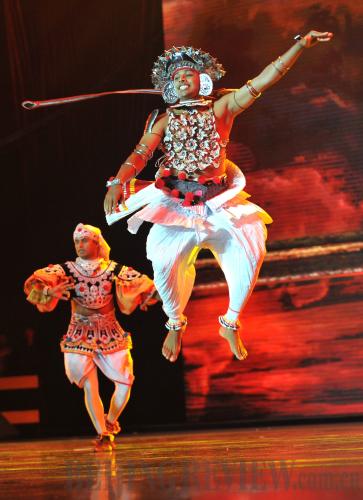|
 |
|
A CONTINENT'S CULTURE: Sri Lankan dancers perform at the opening of the 13th Asia Art Festival in Kunming, southwest China's Yunnan Province, on November 18. Artists from 11 Asian countries participated in the 10-day event (LIN YIGUANG) |
Money in Culture
The Ministry of Finance announced on November 18 that the government recently allocated 4.8 billion yuan ($788 million) to boost the cultural sector.
The amount of funding increased 41.18 percent from 2012, according to a statement on the ministry's website.
So far, the Chinese Government has allocated a total of 14.2 billion yuan ($2.33 billion) to boost the cultural sector, the statement said.
Diabetes Spike
Lifestyle changes have led to increasing incidences of diabetes among China's rural population, a senior health official warned on November 15.
The incidence rate of diabetes among adults in China's rural areas has increased from 1.8 percent in 2002 to 8.4 percent in 2010, said Wang Linhong, a senior official with the Chinese Center for Disease Control and Prevention, at a seminar held in Beijing.
The incidence rate in the countryside increased faster than in cities, though the rate was still lower than that of the latter, Wang said, adding that the rural population has become a priority for diabetes control and prevention efforts.
The national incidence rate of diabetes among adults increased from 2.69 percent in 2002 to 9.7 percent in 2010, while the rates for 2011 and 2012 were not available, according to Wang.
Unhealthy diets and less exercise have caused obesity and higher blood lipid levels amongst the rural population, which could lead to diabetes, Wang said.
Esperanto Museum
China's first museum for Esperanto has officially opened after more than two years of construction to promote the "universal language." Esperanto is a constructed language that was invented by doctor and linguist L.L. Zamenhof in 1887, with the hopes of creating a new language that would be easy enough to learn that everyone in every country could eventually learn it.
The museum, in Zaozhuang University in east China's Shandong Province, opened on November 16 after hosting more than 7,000 visitors during trial operations starting in May.
With a display area covering 680 square meters, the museum is the largest of its kind in Asia, said Sun Mingxiao, who is in charge of the facility.
It boasts more than 26,000 items, including books, newspapers, photographs and manuscripts. The majority of them were donated by Esperanto enthusiasts from more than 40 different countries or regions.
The museum was built by Zaozhuang University in conjunction with the All-China Esperanto League for 3 million yuan ($490,000).
To date, around 400,000 Chinese have learned Esperanto, according to Sun. | 